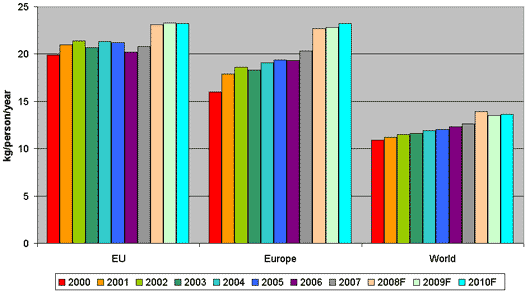



GLOBAL POULTRY TRENDS – European Chicken Meat Consumption
Bringing our series of articles looking at the trends in the chicken meat industry to a close, experienced industry watcher, Terry Evans, turns his attention to future patterns of consumption in Europe.As has been mentioned in previous reports, no countries actually measure chicken/poultry consumption; the published data are assessments of the available supplies adjusted for certain losses, divided by estimates of the human population. Consequently, too much attention ought not to be paid to the absolute levels recorded or to differences between countries but rather seen as a guide to the trend in uptake.
The calculations published by the FAO are for poultry meat rather than chicken. While for most countries, these figures will be virtually identical, clearly the poultry meat figures will need to be adjusted downwards for those countries – and there are only a few – in which significant quantities of turkey, and to a lesser extent waterfowl, are consumed. The chart on available poultry meat supplies (expressed as kg per person per year) gives a good indication of the trend in chicken meat consumption.
The FAO published data for the period 2000 and 2007 reveals that poultry consumption in the EU has broadly been steady at around 21kg per person per year (see Figure 1). The corresponding figures for the whole of Europe show a dramatic rise due to increases in the uptake in eastern Europe countries, such that by 2007, the overall figure for Europe was close to that for the EU.

Clearly, uptake in Europe of around 20.3kg per person is well above the global figure, which, although trending upwards, averaged only 12.6kg in 2007.
Our data for the years 2008 to 2010 in the chart are based on a different set of estimates of poultry meat utilisation than for the earlier years, and therefore cannot be directly compared with the picture shown for 2000-2007. These estimates indicate that average consumption has increased in the EU when compared with previous years but over the three years 2008 to 2010, there has been little change.
For Europe as a whole, the signs are that consumption has continued to edge upwards and is now on a par with the average for the EU. The global picture reveals that the quantities of poultry eaten suffered a setback in 2009, presumably as a result of the impact of the negative economic situation on supplies and the demand for poultry meat. Nevertheless, we assess that 2010 will witness a slight recovery in the average consumption, though not quite to the level reached in 2008.
Looking to 2019, the OECD-FAO forecasts point to average global poultry meat consumption rising from the current estimate of around 13.6kg to almost 15.5kg although almost certainly, most of this increase will occur in the developing economies.
For those countries in northern, southern and western Europe, the average consumption per person showed little change between 2000 and 2007. In contrast, the average for those in eastern Europe almost doubled from 11.2kg to nearly 21kg.
Now to what level can poultry consumption rise? Indeed, how much meat can people eat? Obviously, a large number of factors determine the uppermost level to which total meat consumption can rise. Looking at the Americans, who are the world's biggest meat-eaters, annual consumption of all meats so far in this decade has ranged between 120 and 123kg per person. There has to be an upper limit to the amount of meat people can eat, and this will vary from country to country.
Within the total, the quantity of the different meats eaten primarily reflects changes in the price differentials between meats. In the US, the changes in consumption in recent times have not been great, with poultry uptake trending upwards from 47kg in 2000 to a little over 52kg in 2006 and then falling back to around 50kg in 2007. But, of course, even small increases or decreases of even 100g per person can result in significant movements in the total volume of poultry eaten nationally when large human populations are involved.
For the European Union, the OECD-FAO projections show no change in the average uptake of poultry meat between 2005 and 2015 at around 20.5kg per person.
For most of Europe, increases in the consumption of chicken/person will depend on:
- further improvements in the real incomes of the population
- whether the chicken industries can maintain or improve on their level of competitiveness against other meats and
- how chicken companies innovate to meet changes in consumer demand as additional factors other than the value of the product, such as animal welfare, become more important in influencing consumers' buying behaviour – an aspects of particular importance in developed economies.
Further Reading
| - | You can view other articles in our series Global Poultry Trends by clicking here. |
August 2010












